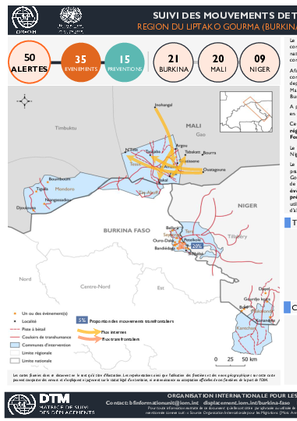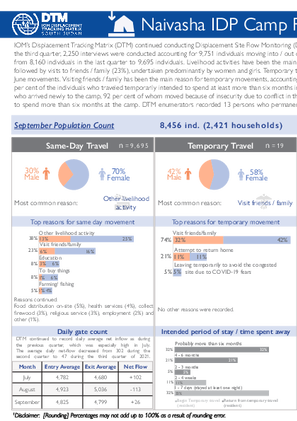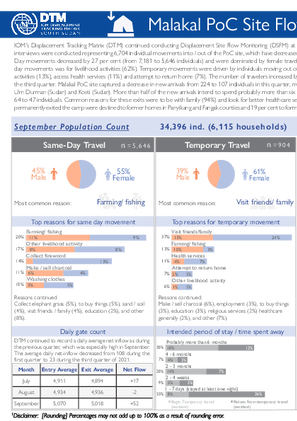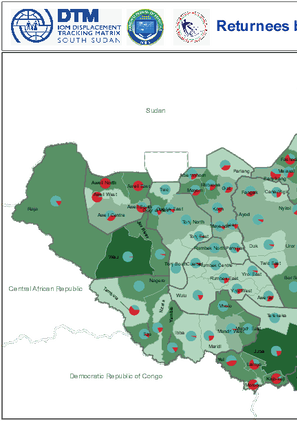-
Countries
-
Data and Analysis
-
Special Focus
-
Crisis Responses

Contact
DTM Nigeria, AllUsersInDTMNigeria@iom.int
Language
English
Location
Nigeria
Period Covered
Aug 30 2021
Oct 15 2021
Activity
- Mobility Tracking
- Baseline Assessment
This document contains a list of the 309 sites assessed during Round 39 of DTM's Mobility Tracking assessments, conducted between 30 August and 15 October 2021. For each site, the document provides the Site I.D., the Site Name, the State, LGA and Ward of the site, as well as the number IDPs present in the site.

Contact
DTM Nigeria, AllUsersInDTMNigeria@iom.int
Language
English
Location
Nigeria
Period Covered
Aug 30 2021
Oct 15 2021
Activity
- Mobility Tracking
- Baseline Assessment
This document contains a list of the 780 wards in which Round 39 of DTM's Mobility Tracking assessments, conducted between 30 August and 15 October 2021, was carried out. The document provides the name of the assessed wards, the State and LGA in which the wards are located, as well as the number of IDPs identified in each ward.

Contact
DTM Nigeria, AllUsersInDTMNigeria@iom.int
Language
English
Location
Nigeria
Period Covered
Aug 30 2021
Oct 15 2021
Activity
- Mobility Tracking
- Baseline Assessment
This report, which presents the results from Round 39 of Displacement Tracking Matrix (DTM) assessments carried out by the
International Organization for Migration (IOM), aims to improve the understanding of the scope of internal displacement, the
plight of returnees and the needs of the displacement affected populations in north-east Nigeria. The report covers the period
from 30 August to 15 October 2021 and reflects the trends from the six states in Nigeria’s north-east geopolitical zone. This
zone is the most affected by the conflict and consists of the following states: Adamawa, Bauchi, Borno, Gombe, Taraba and Yobe.
In Round 39, a total of 2,200,357 Internally Displaced Persons (IDPs) were identified in 452,363 households. This signified an
increase of less than 1 per cent (or 17,744 individuals) compared to Round 38 when 2,182,613 IDPs were recorded (July 2021).
The number of IDPs recorded during Round 39 also increased by 9,164 individuals or less than 1 per cent compared to Round
37 when 2,191,193 IDPs were identified (May 2021). When comparing the number of IDP individuals between Round 39 and
Round 34 (September 2020), the number of IDPs in north-east Nigeria has increased by almost 3 per cent or 56,222 individuals
during the past year.
Furthermore, 1,943,445 returnees were recorded in the DTM Round 39 assessment.1 This number represents an increase of
25,382 individuals or more than 1 per cent compared to Round 38 when 1,918,063 returnees were recorded (July 2021).
During Round 39, IDP assessments were conducted in 2,381 locations (up from 2,380 locations in Round 38) with the purpose of understanding better the gaps in services provided and the needs of the affected population. Site assessments included an analysis of sector-wide needs, shelter and non-food items, water, sanitation and hygiene (WASH), food and nutrition, health, education, livelihood, security, communication and protection.

Contact
DTM Burkina Faso, bfinformationunit@iom.int
Language
French
Location
Burkina Faso
Period Covered
Oct 01 2021
Oct 31 2021
Activity
- Event Tracking
- Other
- Survey
- Flow Monitoring Survey
- Flow Monitoring
- Mobility Tracking
Afin de mieux comprendre les tendances des mouvements transhumants et l’impact des fragilités sur les communautés transhumantes, l’OIM, au travers de sa Matrice de suivi des déplacements (DTM), a déployé depuis juin 2019 l’outil de suivi de la transhumance (Transhumance Tracking Tool – TTT) avec le Réseau Bilital Maroobe (RBM) et ses antennes d’organisations d’éleveurs pour faire le suivi des mouvements de transhumants au Burkina Faso.
Le TTT permet de comprendre les dynamiques liées à la transhumance transfrontalière entre le Burkina Faso, le Niger et le Mali. Il combine trois composantes : la cartographie, le comptage et l’alerte.
Le système d’alerte a pour objectif de recenser les évènements liés à l’utilisation des ressources naturelles, aux pratiques agro-pastorales, ainsi qu’aux désastres naturels dans la région transfrontalière des pays du Liptako-Gourma, de comprendre les modes de résolution de conflits existants et d’informer les autorités compétentes afin de réduire les tensions dans les communes d’intervention. Ce système permet de recenser les alertes liées à un évènement conflictuel (alerte évènement) ou à un mouvement massif ou inattendu de bétail (alerte prévention) qui pourrait provoquer un conflit. Ce rapport présente les données de l’outil d’alerte pour le mois d'octobre 2021.

Contact
DTM South Sudan, SouthSudanDTM@iom.int
Language
English
Location
South Sudan
Period Covered
Jul 01 2021
Sep 30 2021
Activity
- Flow Monitoring
IOM’s Displacement Tracking Matrix (DTM) continued conducting Displacement Site Flow Monitoring (DSFM) at the gates of Naivasha IDP Camp. During the third quarter, 2,250 interviews were conducted accounting for 9,751 individuals moving into / out of the camp. Recorded day movements increased from 8,160 individuals in the last quarter to 9,695 individuals. Livelihood activities have been the main drivers for the increased day movements (38%), followed by visits to friends / family (23%), undertaken predominantly by women and girls. Temporary travels decreased by 5 per cent, relative to April – June movements. Visiting friends / family has been the main reason for temporary movements, accounting for 74 per cent of temporary travels. Thirty-two per cent of the individuals who traveled temporarily intended to spend at least more than six months in / out of the camp. DTM surveyed 24 individuals who arrived newly to the camp, 92 per cent of whom moved because of insecurity due to conflict in their areas of departure. All the new arrivals intend to spend more than six months at the camp. DTM enumerators recorded 13 persons who permanently left the camp with all exits destined to Wau.
Contact
DTMAfghanistan@iom.int
Location
Afghanistan
Activity
- Site Assessment
- Mobility Tracking
Period Covered
Apr 01 2021 -Jun 30 2021
A Community-Based Needs Assessment (CBNA), intended as an integral component of DTM's Baseline Mobility Assessment to provide a more comprehensive view of multi-sectoral needs in settlements hosting IDPs and returnees.
Population Groups
Survey Methodology
Unit of Analysis Or Observation
Type of Survey or Assessment
Keywords
Geographical Scope
Administrative boundaries with available data
The current dataset covers the following administrative boundaries

Contact
DTM South Sudan, SouthSudanDTM@iom.int
Language
English
Location
South Sudan
Period Covered
Jul 01 2021
Sep 30 2021
Activity
- Flow Monitoring
IOM’s Displacement Tracking Matrix (DTM) continued conducting Displacement Site Flow Monitoring (DSFM) at the gates of Malakal PoC Site. During this period, 3,135 interviews were conducted representing 6,704 individual movements into / out of the PoC site, which have decreased compared to 8,280 movements in the previous quarter. Day movements decreased by 27 per cent (from 7,181 to 5,646 individuals) and were dominated by female travelers (55%). Among all respondents, the main reason for day movements was for livelihood activities (62%). Temporary movements were driven by individuals moving out of the site to visit friends / family (37%), tend to livelihood activities (13%), access health services (11%) and attempt to return home (7%). The number of travelers increased by 10 per cent, from 811 in the previous quarter to 904 in the third quarter. Malakal PoC site captured a decrease in new arrivals from 224 to 107 individuals in this quarter, most of whom arrived from Panyikang, Fangak, Ayod, Juba, Um Durman (Sudan) and Kosti (Sudan). More than half of the new arrivals intend to spend probably more than six months in the site. Permanent exits also decreased from 64 to 47 individuals. Common reasons for these exits were to be with family (94%) and look for better healthcare services (6%). Seventy-four per cent of the individuals who permanently exited the camp were destined to former homes in Panyikang and Fangak counties and 19 per cent to former areas but new homes in Kosti and Um Durman (Sudan).

Contact
DTM South Sudan, SouthSudanDTM@iom.int
Language
English
Location
South Sudan
Period Covered
Jul 01 2021
Sep 30 2021
Activity
- Flow Monitoring
IOM’s Displacement Tracking Matrix (DTM) continued conducting Displacement Site Flow Monitoring (DSFM) at the gates of Wau Masna Collective Centre. In the third quarter of 2021, 2,462 interviews were conducted representing 4,248 individual movements in and out of the collective centre. Day movements saw a 26 per cent increase relative to the previous quarter. These movements were mainly driven by male travelers (62%), and the main reasons for travel were to tend to livelihood activities (29%) and to look for better health services (11%). Temporary movements saw a 12 per cent decrease compared to the previous quarter with the main reason being farming / fishing (48%). Ninty-three per cent of the individuals traveling temporarily intend to spend at least more than six months in / out of the collective centre. The third quarter recorded a significant decrease in new arrivals from 284 in the previous quarter to 7 individuals. Eighty-six per cent of the individuals who newly arrived in the collective centre moved because of hunger due to conflict, and 14 per cent due to insecurity related to conflict in their areas of departure. All individuals intend to spend more than six months at the centre. DTM did not encounter persons intending to permanently leave the collective centre this reporting period.

Contact
DTM South Sudan, SouthSudanDTM@iom.int
Language
English
Location
South Sudan
Period Covered
Jul 01 2021
Sep 30 2021
Activity
- Flow Monitoring
IOM’s Displacement Tracking Matrix (DTM) continued conducting Displacement Site Flow Monitoring (DSFM) at the gates of Bentiu IDP Camp. The third quarter (July – September) recorded 6,792 interviews accounting for 27,034 individuals moving into / out of the camp. Day movements increased this quarter by 8 per cent (from 9,332 to 10,106 individuals) and were dominated by women and girls (74%). Among all respondents, the main reason for day movements were to collect firewood (20%). Temporary movements were driven by individuals moving out of the camp to collect firewood (19%), visiting friends / family (18%) and attempting to return home (17%). The number of travelers has increased from 12,205 to 16,505 individuals (35% increase compared to the second quarter). Bentiu IDP Camp recorded a 27 per cent decrease in new arrivals most of whom arrived from Rubkona, Panyijar, Khartoum (Sudan) and Jabal Aulia (Sudan). Eighty-nine per cent of the new arrivals intend to spend more than six months in the camp. Permanent exits decreased drastically from 737 in the second quarter to 272 individuals during this quarter. Common reasons for these exits were to be with family (35%), to look for livelihood / work opportunities (16%), and due to improved living conditions at locations of destination (14%). Seventy-three per cent of the individuals who permanently exited the camp were destined to former homes in Rubkona and Guit counties.
